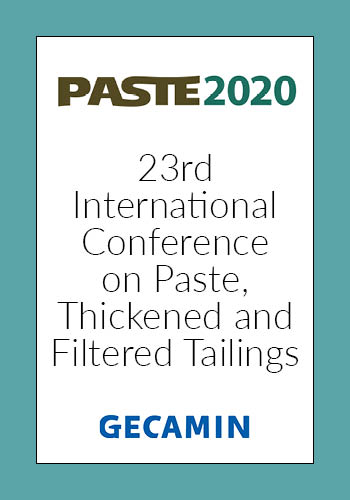Paste and Thickened Tailings Transportation Design Aspects Overview

|
Authors: Javadi, S; Pirouz, B; Slatter, P |
DOI https://doi.org/10.36487/ACG_repo/2052_93
Cite As:
Javadi, S, Pirouz, B & Slatter, P 2020, 'Paste and Thickened Tailings Transportation Design Aspects Overview', in H Quelopana (ed.), Paste 2020: 23rd International Conference on Paste, Thickened and Filtered Tailings, Gecamin Publications, Santiago, https://doi.org/10.36487/ACG_repo/2052_93
Abstract:
Tailings transport is an integrated element in any wet tailings storage facility (TSF). Tailings from the process plant are often thickened to a moderate or relatively high (but still pumpable) solids concentration, depending on several parameters mainly the TSF deposition requirements and strategies, process plant water security status and the dewatering technology utilised. This paper overviews the transportation of paste and thickened tailings and discusses various aspects and considerations in the hydraulic design of the system. Material characteristics, flow behaviour assessment (rheological behaviour measurement and interpretation) and the basis of design definition are discussed. The recent developments in environmental authorities’ regulations associated with the tailings pipeline burst and leakage management are also reviewed in this paper. The tailings leakage and spillage to the environment is one the main concerns for any tailings hydraulic transportation system, therefore as part of the tailings pipeline design, the pipeline integrity failure (due to pipe wear, overpressure bursting etc.) should be thoroughly analysed to propose proper mitigation measures. The paper discusses a methodology to assess the potential tailings volume release to the environment in an event of the pipeline integrity failure which would be of interest to the operators and designers.
References:
Fraser, C & Goosen, P (2019), Evaluation of a non-Newtonian two-layer model for high concentration suspensions, in AJC Paterson, AB Fourie & D Reid (eds), Proceedings of the 22nd International Conference on Paste, Thickened and Filtered Tailings, Australian Centre for Geomechanics, Perth, pp. 531-539,
Seddon, KD, Pirouz, B & Javadi, S (2018), Stochastic modelling of beach profiles including the influence of thickener performance, in RJ Jewell & AB Fourie (eds), Proceedings of the 21st International Seminar on Paste and Thickened Tailings, Australian Centre for Geomechanics, Perth, pp. 251-260
Pirouz, B., Javadi, S., Seddon, K.D. (2017) Thickener performance variability: underflow solids concentration and flowrate, Proceedings 20th International Seminar on Paste and Thickened Tailings (Paste 2017), Beijing, China, pp. 10-11.
Seddon, K.D. and Fitton, T.G. (2011), Realistic beach slope prediction and design, in R.J. Jewell and A.B. Fourie (eds), Proceedings of the 14th International Seminar on Paste and Thickened Tailings, Australian Centre for Geomechanics, Perth.
Paterson, A.J.C. (2011), The pipeline transport of high density slurries- a historical review of past mistakes, lessons learned and current technologies, in R.J. Jewell and A.B. Fourie (eds), Proceedings of the 14th International Seminar on Paste and Thickened Tailings, Australian Centre for Geomechanics, Perth.
Slatter, P. (2011), The engineering Hydrodynamics of Viscoplastic Suspensions, Journal of Particulate Science and Technology, 29: 2, pp 139-150
Slatter, P. T., Wasp, E. J., (2000),’The laminar/turbulent transition in large pipes’,10th International Conference on Transport and Sedimentation of Solid Particles, Wrocław: 4-7 September, 2000.
Yánez, R & Tapia (2018), Tailings transport on high yield stress requirements: turbulent or laminar flow?, in RJ Jewell & AB Fourie (eds), Proceedings of the 21st International Seminar on Paste and Thickened Tailings, Australian Centre for Geomechanics, Perth, pp. 217-226,
© Copyright 2025, Australian Centre for Geomechanics (ACG), The University of Western Australia. All rights reserved.
View copyright/legal information
Please direct any queries or error reports to repository-acg@uwa.edu.au
View copyright/legal information
Please direct any queries or error reports to repository-acg@uwa.edu.au